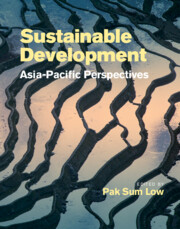Book contents
- Sustainable Development: Asia-Pacific Perspectives
- Sustainable Development: Asia-Pacific Perspectives
- Copyright page
- Dedication
- Contents
- Notes on contributors
- Peer reviewers
- Editor’s note
- Foreword
- Foreword
- Foreword
- Foreword
- Foreword
- Environmental keystones: Remembering Dr Mostafa Kamal Tolba
- Remembering Dr Mostafa Kamal Tolba
- Remembering Dr Mostafa Kamal Tolba
- Acronyms and abbreviations
- SI prefixes
- Unit abbreviations
- Chemical formulae
- Part I Sustainable Development: Theories and Practices
- Part II Sustainable Development: Challenges and Opportunities
- 17 Scientific responses in an era of global change
- 18 Government communication on transboundary haze: The nexus between public health and tourism
- 19 Biomass energy prospects: A promising fuel for sustainable development in Asia and the Pacific
- 20 Pathways to a more sustainable electricity sector in India
- 21 Gender equality and energy access: Barriers to maximizing development effectiveness in the SAARC region
- 22 The biosphere and the interactions between stratospheric ozone depletion and climate change
- 23 The political challenge of linking climate change and sustainable development policies: Risks and prospects
- 24 Social vulnerability to climate change in Cambodia, Lao PDR, and Vietnam
- 25 Sustainable development in Bangladesh: Bridging the SDGs and climate action
- 26 Sustainable development in Pakistan: Vulnerabilities and opportunities
- 27 Beyond protected areas: Biodiversity conservation and global change in Asia and the Pacific
- 28 Causes of land-use change and biodiversity loss in Monsoon Asia
- 29 Assessing linkages between land use and biodiversity: A case study from the Eastern Himalayas using low-cost, high-return survey technology
- 30 Where to invade next: Inaction on biological invasions threatens sustainability in a small island developing state of the tropical South Pacific
- 31 Did the Indian Ocean tsunami trigger a shift towards disaster risk reduction?
- 32 Cyclone Nargis and disaster risk management in Myanmar
- Index
- Endmatter
- References
18 - Government communication on transboundary haze: The nexus between public health and tourism
from Part II - Sustainable Development: Challenges and Opportunities
Published online by Cambridge University Press: 23 December 2021
- Sustainable Development: Asia-Pacific Perspectives
- Sustainable Development: Asia-Pacific Perspectives
- Copyright page
- Dedication
- Contents
- Notes on contributors
- Peer reviewers
- Editor’s note
- Foreword
- Foreword
- Foreword
- Foreword
- Foreword
- Environmental keystones: Remembering Dr Mostafa Kamal Tolba
- Remembering Dr Mostafa Kamal Tolba
- Remembering Dr Mostafa Kamal Tolba
- Acronyms and abbreviations
- SI prefixes
- Unit abbreviations
- Chemical formulae
- Part I Sustainable Development: Theories and Practices
- Part II Sustainable Development: Challenges and Opportunities
- 17 Scientific responses in an era of global change
- 18 Government communication on transboundary haze: The nexus between public health and tourism
- 19 Biomass energy prospects: A promising fuel for sustainable development in Asia and the Pacific
- 20 Pathways to a more sustainable electricity sector in India
- 21 Gender equality and energy access: Barriers to maximizing development effectiveness in the SAARC region
- 22 The biosphere and the interactions between stratospheric ozone depletion and climate change
- 23 The political challenge of linking climate change and sustainable development policies: Risks and prospects
- 24 Social vulnerability to climate change in Cambodia, Lao PDR, and Vietnam
- 25 Sustainable development in Bangladesh: Bridging the SDGs and climate action
- 26 Sustainable development in Pakistan: Vulnerabilities and opportunities
- 27 Beyond protected areas: Biodiversity conservation and global change in Asia and the Pacific
- 28 Causes of land-use change and biodiversity loss in Monsoon Asia
- 29 Assessing linkages between land use and biodiversity: A case study from the Eastern Himalayas using low-cost, high-return survey technology
- 30 Where to invade next: Inaction on biological invasions threatens sustainability in a small island developing state of the tropical South Pacific
- 31 Did the Indian Ocean tsunami trigger a shift towards disaster risk reduction?
- 32 Cyclone Nargis and disaster risk management in Myanmar
- Index
- Endmatter
- References
Summary
Haze has been a serious transboundary problem in Southeast Asia for decades. Originating largely from fires in Indonesia, the smoke travels across borders, affecting up to six Southeast Asian states almost annually. Haze contains fine particles which irritate the eyes and penetrate the lungs. As a result, scores of Indonesians, Malaysians, and Singaporeans suffer from respiratory, dermatological, and ophthalmological problems. These health risks, together with reduced visibility, have also caused tourist numbers to drop dramatically. This chapter observes that governments worked hard to protect and maintain their tourism sectors in the face of the haze. The main tactic used was to underrepresent the health risks of haze, both to citizens and tourists. As a result, regional governments largely failed to recognize the haze as a serious public health issue. At the national level, states often under-report health effects in the attempt to keep tourism levels stable. At the regional level, member states have yet to agree on a common ASEAN-wide regional air quality measurement system, with many continuing to use a system that tends to underrepresent health risks. At the international level, affected states have been quick to debunk research that indicates higher levels of mortality. As a result, citizens lack the awareness and sense of urgency to make wise health and well-being decisions during haze episodes. Sustainable development involves economic growth balanced with social development and environmental sustainability. However, the case of the haze shows that Southeast Asian states still find it challenging to balance these elements in the spirit of sustainable development.
Keywords
- Type
- Chapter
- Information
- Sustainable Development: Asia-Pacific Perspectives , pp. 220 - 230Publisher: Cambridge University PressPrint publication year: 2022

